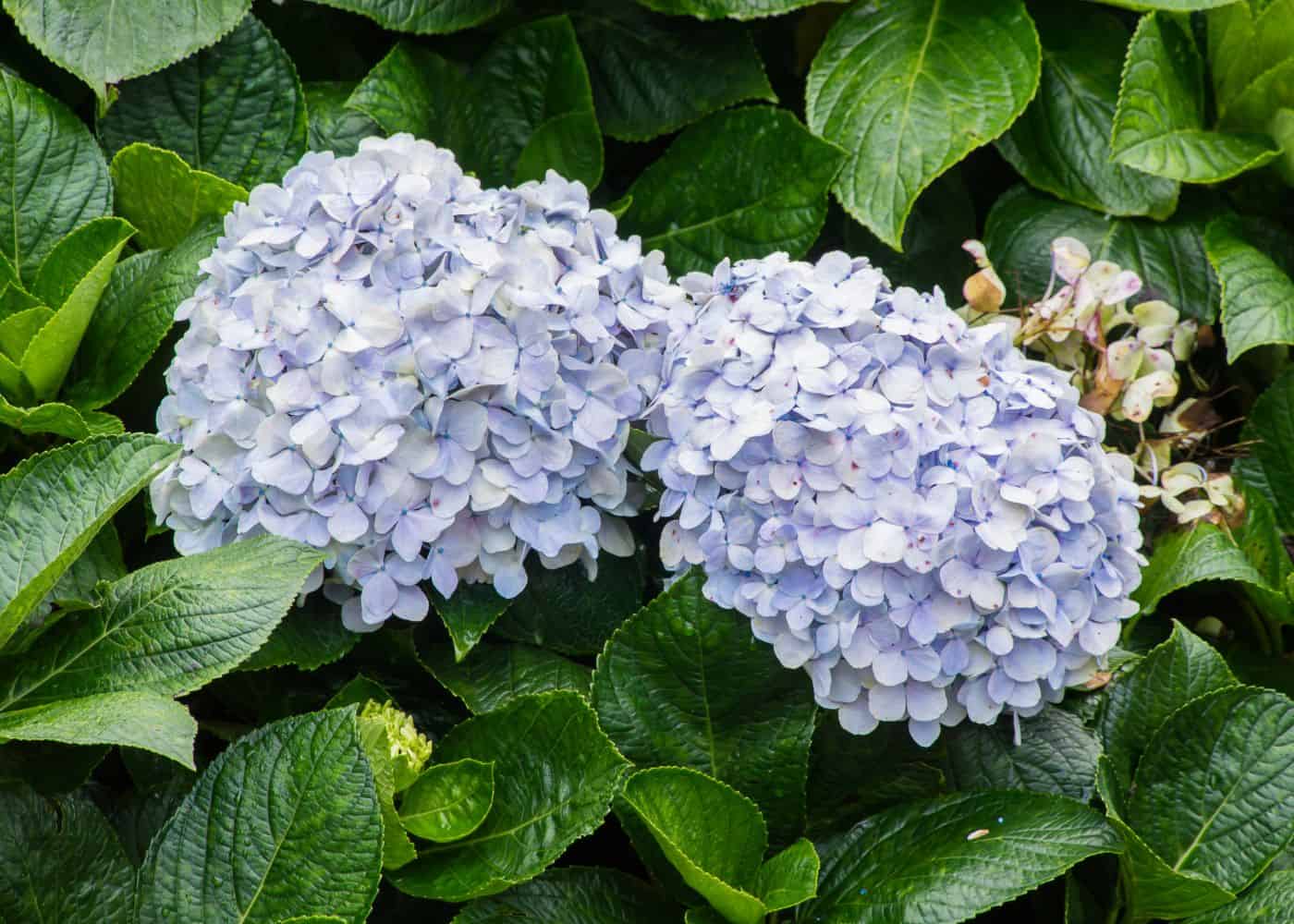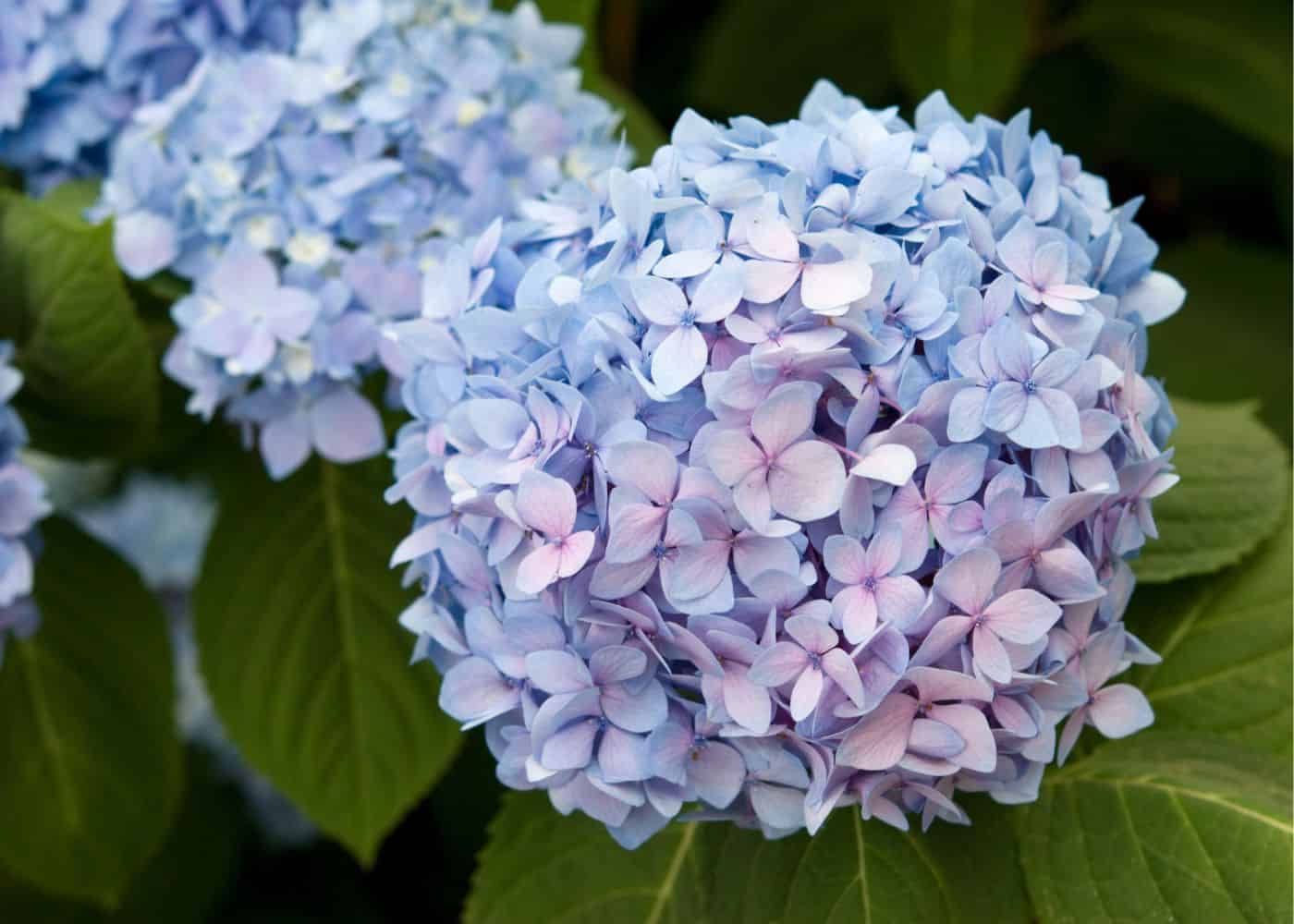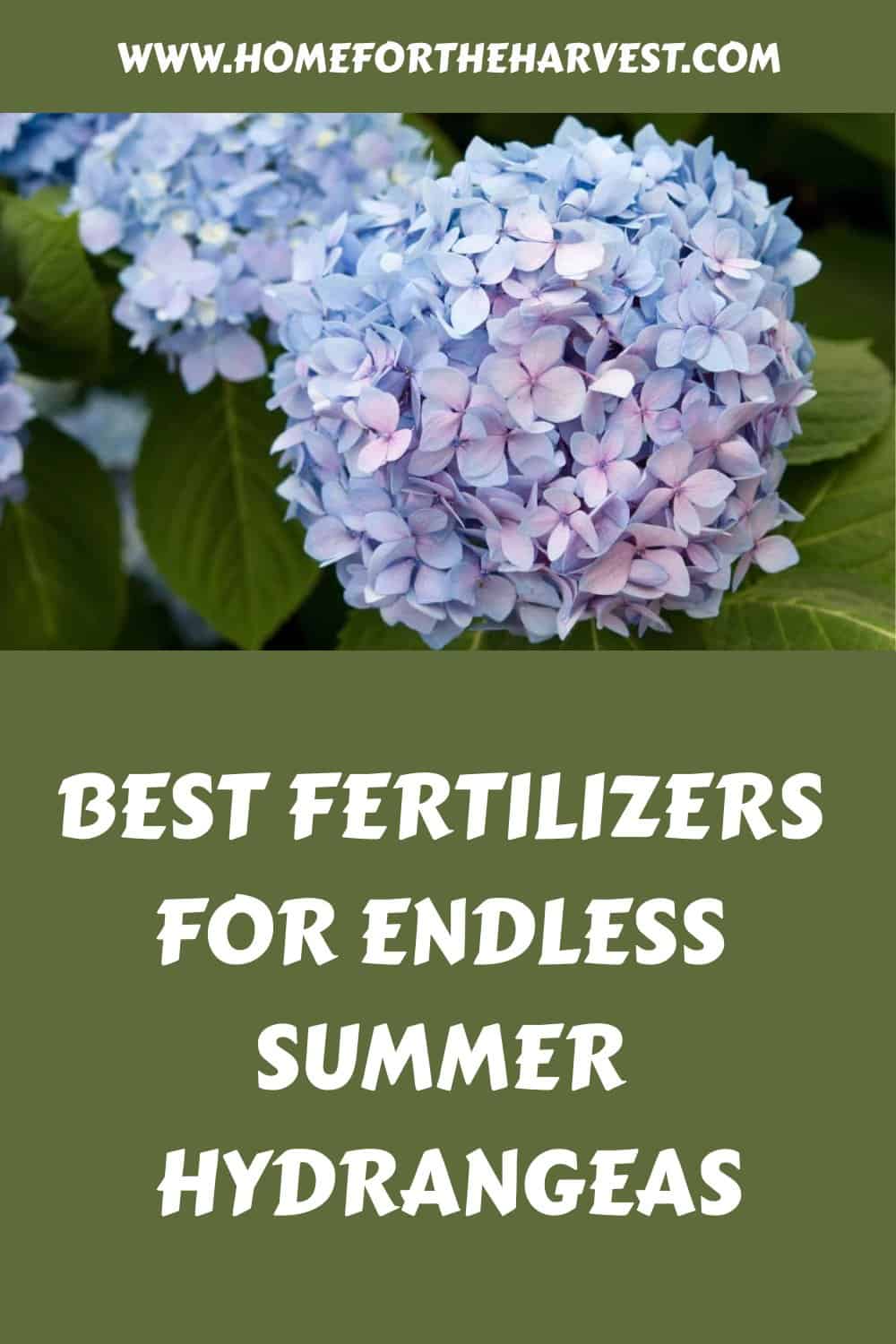The best fertilizer products for Endless Summer hydrangeas tend to be slow-release granular products with a balanced NPK ratio plus minor nutrients like iron. One application of fertilizer in the spring is usually enough for these plants. Avoid overfertilizing, as it can actually inhibit bloom production and limit color intensity. Also, avoid high-nitrogen fertilizers, which can cause vigorous green growth at the expense of flowers.
Soil pH is also very important when fertilizing these plants. For optimal nutrient availability, the soil should have a pH between 5.5 and 6.5, if possible. You can adjust soil pH with various soil amendments.
For blue flowers, use a soil acidifier containing sulfur and/or gypsum. Aluminum sulfate can also increase the blue effect. For pink flowers, use garden lime (dolomite lime) to raise the pH.

Best fertilizer for Endless Summer hydrangeas
When it comes to fertilizing Endless Summer hydrangeas, the best option is a balanced fertilizer with roughly equal parts nitrogen (N), phosphorus (P), and potassium (K). Nitrogen helps promote healthy foliage growth, while phosphorus encourages root development. Potassium aids in flower production and overall plant health.
In addition to NPK, pay attention to the amounts of iron and other key minor nutrients like boron. Certain minor nutrients can be lacking or unavailable in certain soil types, meaning that your plant may develop a deficiency over time. A soil test is a good way to get insight into what may be available to your plant, but sometimes the foliage is the key to diagnosing a deficiency. In the absence of testing, use a complete fertilizer.
Applying too much fertilizer can cause your plants to become over-fertilized, resulting in fewer blooms or even stunted growth. To avoid this, use only the recommended amount of fertilizer for your particular type of hydrangea. Always follow the instructions on the label!
One last note about fertilizer basics for Hydrangea macrophylla is that the soil pH can affect whether or not the plant can actually absorb the nutrients that are in the soil. In general, these hydrangea plants perform best overall when the soil pH is between 5.5-6.5 when the flower color is “blurple”. That said, it can take a pH lower than 5.5 (plus aluminum) to get a truly blue flower and often a pH above 6.5 to get a deep pink flower.
When to apply fertilizer
The best time to apply fertilizer is when the foliage starts to emerge in the spring. This is usually in the month of February or March, or even into early April, depending on local conditions. Visible leaves indicate that the shrub is actively drawing up water (and soluble minerals) from the roots. This timing will give your plants plenty of nutrients throughout their growing season so they can produce beautiful blooms all summer long! A garden soil test can help let you know if you need additional applications of fertilizer in particularly poor soil.

How to change flower color with fertilizer
Endless Summer hydrangeas are known for producing either pink and blue flowers depending on soil pH levels. Acidic soils result in blue flowers, while alkaline soils produce pink ones.
If you want to change the color of your flowers, simply adjust the pH level by adding either lime or sulfur accordingly before applying any fertilizer. Some specialized hydrangea fertilizers even have them mixed right in for a one-step application.
Tips for applying fertilizer
Always read product labels carefully before application, as different types may require different amounts or methods of application; some may need watering immediately after application, while others do not need water at all. Avoid getting any fertilizer on leaves as this could burn them – instead, focus on applying it directly into soil near roots where it can be absorbed quickly without causing damage above ground.
Make sure not to overdo it – just because one bag says “apply once a month” doesn’t mean that it’s necessarily required for your individual soil conditions. More is not better when it comes to fertilizer, as it can burn plants, pollute groundwater, and waste money. Err on the side of caution unless you have specific instructions from a soil test or are observing signs of nutrient deficiency.
Best fertilizer for blue flowers on Endless Summer hydrangeas
If you’re looking for blue blooms, then you should look for a soil acidifier product that contains elemental sulfur and sometimes added gypsum. These products help make the soil more acidic, which in turn helps produce beautiful blue flowers. The addition of aluminum sulfate can also help increase the deepness of the blue tone.
It is important to note that these products are not always necessary if your soil is already naturally acidic or if you live in an area with high levels of rainfall or humidity as this can also affect flower color. Additionally, using too much sulfur or gypsum can cause problems if soil gets too acidic, so be sure to follow directions carefully when applying them to your garden beds. Strongly acidic soils with a pH below about 5.5 can limit the availability of important nutrients like nitrogen, phosphorus, and potassium.
In addition to using a soil acidifier product, there are several other ways you can affect flower color on Endless Summer hydrangeas including adjusting pH levels by adding lime or aluminum sulfate; planting near trees with deep roots; and providing adequate sunlight exposure (4-6 hours per day).
Finally, here are some tips for applying fertilizer: start by removing any weeds from around the base of each plant; spread evenly across all areas where blooms will appear; water thoroughly after application, and monitor regularly throughout the season for signs of nutrient deficiency such as yellowing leaves or stunted growth. With these simple steps, you can enjoy vibrant blue blooms all summer long.
Best fertilizer for pink flowers on Endless Summer hydrangeas
The best fertilizers for pink flowers on Endless Summer hydrangeas contain garden lime, also called dolomite limestone. This natural material helps neutralize soil acidity and adds essential nutrients like calcium and magnesium back into the soil. In overly acidic soils, it will help keep your plant’s pH levels balanced so that it can absorb more nutrients from other fertilizers you may use throughout the season as well.
When applying garden lime or any other fertilizer to an Endless Summer hydrangea, start with a small amount first (about one cup per bush). If needed, you can increase this amount up to two cups per bush after observing how your plants respond over time. Be sure not to over-fertilize though; too much fertilizer can cause damage or even kill your plants!
It is best to apply garden lime once every three months during spring and summer when temperatures are warmer and rainfall is more frequent than in winter months. You should also avoid applying it during periods of drought since too much water could wash away some of its benefits before they have a chance to take effect on your plants.
How to fertilize Endless Summer hydrangeas
Fertilizing your Endless Summer hydrangeas is an important part of keeping them healthy and blooming. Applying fertilizer at the right time can help ensure that your plants have enough nutrients to produce beautiful blooms throughout the season.
The best time to apply fertilizer for your Endless Summer hydrangeas is in spring when the plant begins to grow actively again after winter dormancy. Typically this is around March. This will give it a boost of energy and provide essential nutrients needed for growth and flowering. If you wait too long, you may miss out on some of the benefits of fertilizing as well as risk stressing out your plants due to lack of nutrition.
When applying fertilizer, be sure not to overdo it! Too much fertilizer can cause damage or even kill your plants, so always follow package instructions carefully when determining how much should be applied per application.
There are many different types of fertilizers available for use with Endless Summer hydrangeas – from organic options like composted manure or fish emulsion to synthetic varieties. Choose one that best suits your needs based on what’s available in your area and what works best with the particular variety you’re growing. Additionally, there are special formulations designed specifically for acid-loving plants such as azaleas and rhododendrons which work great with Endless Summers too.
Once you’ve chosen a suitable fertilizer product for use with your hydrangea bush(es), determine whether it should be applied directly onto foliage (foliar feeding) or into the soil around roots (root feeding). For foliar feeding products, simply mix according to directions, then spray evenly onto leaves until they appear wet but not dripping. Root feeders require mixing according to directions and then spreading evenly around the base of the plant using either a shovel or hand spreader tool before lightly watering in afterward if necessary.
There are a few things to avoid when fertilizing these shrubs. Never apply the fertilizer to frozen soil (even if you are sure it is “early spring”). Don’t pile fertilizer up around the stems of the plant. Instead, sprinkle it on the soil around the perimeter where the roots are. Don’t let fertilizer touch wet foliage, as it can burn the plants. And don’t forget to water after applying fertilizer, as the nutrients must be in a water solution to be absorbed by the plant.
How to change flower color with fertilizer
Fertilizer can be a great way to help your Endless Summer hydrangeas bloom in beautiful colors. By altering the pH of the soil and controlling the amount of aluminum, you can create blue or pink flowers depending on what type of fertilizer you use.
To get blue flowers, try using a soil acidifier with sulfur and gypsum. This will lower the pH level of your soil and cause the blooms to turn blue. Make sure to follow package instructions for application rates and timing so that you don’t overdo it! A soil pH of 5.5 is usually a good target for blue flowers (although you can decrease it below 5 in certain conditions). Adding some aluminum sulfate can also help increase the blue effect.
If you want pink flowers instead, adding lime is an easy solution. Lime raises the pH level of your soil, which encourages pink blooms on Endless Summer hydrangeas. Again, make sure to follow package instructions for application rates and timing when using lime as well! A soil pH of about 6.5 is ideal for pink flowers (although you may need more like 7.0 for deep pink).
It’s important to note that if you already have established plants in place, it may take several weeks before any changes are visible due to flower color being determined by last year’s growth rather than this year’s growth cycle. It also helps if your plants get plenty of sunlight throughout the day – 6-8 hours is ideal – as this will encourage more vibrant blooms regardless of color!
Finally, keep in mind that some varieties naturally produce different colored blooms even without fertilizer adjustments, so always check labels carefully before making any decisions about what type of fertilizer would work best for your particular plant variety. The original ‘Endless Summer’ hydrangea is easy to change from pink to blue, but the brand line now contains other varieties that differ in their genetic makeup.






